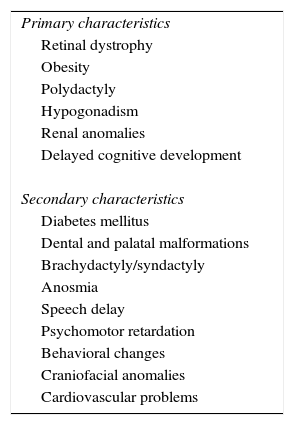Bardet–Biedl syndrome (BBS) is a multisystemic genetic disorder, which is not widespread among the Caucasian population, characterized by a highly variable phenotype and great genetic heterogeneity. BBS belongs to a group of diseases called ciliopathies, caused by defects in the structure and/or function of cilia. Due to the diagnostic complexity of the syndrome, the objective of this study was to analyze our whole group of patients in order to create an algorithm to facilitate the routine molecular diagnosis of BBS. We also calculated several epidemiological parameters in our cohort.
Patients and methodWe analyzed 116 BBS patients belonging to 89 families from the whole Spanish geography. All probands fulfilled diagnosis criteria established for BBS. For this, we used: genotyping microarray, direct sequencing and homozygosis mapping (in consanguineous families).
ResultsBy means of the different approaches, it was possible to diagnose 47% of families (21% by genotyping microarray, 18% by direct sequencing of predominant BBS genes, and 8% by homozygosis mapping). With regard to epidemiological data, a prevalence value of 1:407,000 was obtained for BBS in Spain, and a sex ratio of 1.4:1 (men:women).
ConclusionsThe proposed algorithm, based on the analysis of predominant BBS genes combined with homozygosis mapping, allowed us to confirm the molecular diagnosis in a significant percentage of families with clinically suspected BBS. This diagnostic algorithm will be useful for the improvement of the efficiency of molecular analysis in BBS.
El síndrome de Bardet-Biedl (SBB) es una enfermedad genética multisistémica poco frecuente en población caucásica, caracterizada por una pronunciada variabilidad fenotípica y una gran heterogeneidad genética. Pertenece al grupo de las ciliopatías, causadas por defectos en la estructura y/o función ciliar. Dada la gran complejidad diagnóstica del síndrome, el objetivo de este estudio ha sido analizar el conjunto global de afectados recogidos para elaborar un algoritmo que facilite el diagnóstico molecular rutinario del SBB, así como calcular algunos parámetros epidemiológicos para población española.
Pacientes y métodoSe han analizado 116 afectados de SBB pertenecientes a 89 familias procedentes de toda la geografía española. Todos los probandos cumplían los criterios diagnósticos establecidos para el SBB. Para ello, se utilizaron las siguientes técnicas: microchip de genotipado, secuenciación directa y microchip de homocigosidad para familias consanguíneas.
ResultadosHa sido posible diagnosticar al 47% de las familias (21% mediante el microchip de genotipado, 18% mediante secuenciación directa de genes BBS predominantes y 8% mediante el mapeo de regiones homocigotas). En cuanto a los datos epidemiológicos, se obtuvo un valor de prevalencia del SBB en España de 1:407.000, así como una razón por sexos de 1,4:1 (varones:mujeres).
ConclusionesEl algoritmo propuesto, basado en el análisis de genes BBS predominantes combinado con estudios de homocigosidad, ha permitido confirmar el diagnóstico molecular en un porcentaje significativo de familias con sospecha clínica de SBB. Este algoritmo diagnóstico permitirá optimizar el análisis molecular del SBB.










